By Richard Criley and Dr. Jasminka Criley
During the past few months, I have received many questions about N95 respirators. Why are they called respirators, and not masks? Who are they for? Are they better than “regular” masks? Who should wear these respirators, and who benefits from wearing them? Which masks are appropriate for which task, and for which people?
N95 respirators and surgical masks are examples of PPE (personal protective equipment). They are used to protect the wearer from airborne particles and liquids. Lack of proper PPE puts healthcare workers at personal risk when they encounter patients infected with the virus. In addition to PPE, other infection control practices (i.e. hand washing, using alcohol-based hand sanitizers and covering coughs and sneezes) are necessary to minimize the spread of infection from one person to another. PPE generally includes gloves, a gown, boots or closed-toe work shoes, eye protection, medical masks and respirators.
~ What is the difference between a mask and a respirator?
A mask, such as a surgical mask, simply covers the nose and mouth of the wearer. They are designed to stop large droplets and splashes or sprays. Masks do not create a tight seal nor are they to filter small airborne contaminants.

In contrast, a respirator forms an airtight seal against the skin of the wearer. As such, they are designed to reduce exposure to airborne contaminants and pathogens (including TB, SARS, COVID19, anthrax, hantavirus etc).
~ How are respirators and masks certified?
In the United States, medical face masks must meet technical standards developed by the ASTM (American Society of Testing and Materials) and referenced by FDA (Food and Drug Administration).
On the other hand, the organization that sets standards and performs tests for respirators is the NIOSH (National Institute for Occupational Safety),which is part of the CDC (Center for Disease Control and Prevention).
~ What is the classification system?
The classification system includes a letter and a number, which give the wearer all the information needed to determine the effectiveness of a respirator.
The letters include: N, R and P.
The numbers include: 95, 99 and 100.
The letter denotes a respirator’s capability to filter oil. Oil and fat-based particles are very small and “slippery.” As a result, they can often penetrate a filter in a way that non-oil particles cannot.
N-rated respirators are not resistant to oil-based particles. They are the most common variety of respirators. They can be used for about 8 hours to provide adequate protection from most particles.
R-rated respirators are resistant to oil-based particles. They are a less common variety of respirators. They are inconvenient to use because the filter inside an R-rated respirator can clog up over time. Because of R-rated respirators’ susceptibility to clogging, they are only effective for about 8 hours of use.
P-rated respirators are classified as oil-proof. They are even more effective in filtering out particles than R-rated respirators. Additionally, P-rated respirators last much longer, for about 40 hours, or 30 days of use.
The number denotes the percentage of particles that a respirator is capable of filtering.
95-rated respirators filter out 95% of all particles. These respirators are good for short-term use. However, longer-term exposure substantially increases the risk of potentially dangerous particles entering the wearer’s airway.
99-rated respirators filter out 99% of all particles. These respirators are much more effective than 95-rated respirators. However, for much longer-term use, they still pose a small amount of risk.
100-rated respirators filter 99.97% particles. These are the most effective respirators commercially available. The very small number of particles that penetrate the filter pose a risk that is considered negligible.
In summary – the “weakest” respirator that still receives a classification is N-95 – which filters 95% of non-oil particles. The strongest is P100 – which filters 99.97% of oil and non-oil particles.
This classification, however, applies only to certified respirators that have been tested and approved by NIOSH. This approval, however, takes a while as it involves the whole bunch of different testing on the seal, filtration efficiency (particulate filtration and bacterial filtration efficiency), fluid resistance, flammability, biocompatibility and the quality of materials. As a result, many mask-makers do not certify their products.
Most N95 respirators are manufactured for use in construction and other industrial jobs, but some N95 respirators are intended for use in health care settings. At the time of COVID19 pandemic N95 respirators have been prioritized for healthcare workers and first responders and are not available to the public for general use.
Here is a brief summary of different types of face masks and respirators, and who can benefit from wearing them.
N95 Masks/Respirators
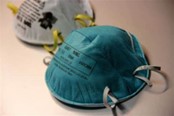
Purpose
N95 masks filter out at least 95% of the wearer’s exposure to very small particles (down to 0.3 microns), aerosols and large droplets. They are not designed to protect the wearer against gases or vapors. The edges of the respirator are designed to form a seal around the nose and the mouth. Some N95 masks have valves that make it easier to breathe through.
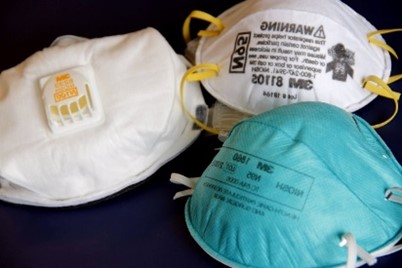
Every country has their own independent certification system. Accordingly, N95 masks have different names in different countries:
N-95 (United States NIOSH-42CFR84)
FFP2 (Europe EN 149-2001)
KN95 (China GB2626-2006)
P2 (Australia/New Zealand AS/NZA 1716:2012)
Korea 1st Class (Korea KMOEL – 2017-64)
DS (Japan JMHLW-Notification 214, 2018)
Despite some similarities, there are slight differences:
N-95 – filter performance >95%
FFP2 – filter performance >94%, looser fitting
KN95 – filter performance >95%
P2 – filter performance >94%,
Korea 1st Class – filter performance >94%,
DS – filter performance >95%
Positioning
N95 masks require a tight facial seal. Seal tightness must be tested by the user after donning (equipping or putting on). When the respirator is properly fitted, there should only be minimal leakage around the edges with inhalation. They cannot be used on facial hair.
Reusability
Ideally, N95 masks should be discarded after each patient encounter and after aerosol-generating procedures. Otherwise, N95 masks last for about 8 hours of use.
Cost
~ $1.50 – $7 per unit
COVID-19 Information
Due to a shortage, N95 masks should be prioritized for healthcare workers. CDC does not recommend that the general public wears N95 respirators to protect themselves from respiratory diseases, including coronavirus (COVID-19). The most common N95 respirators are disposable and not designed for extended use, but healthcare workers may be directed to re-wear them during emergency shortages (CDC-NIOSH March 13, 2014). Researchers are testing ways to disinfect N95 masks so they can be reused. Healthcare workers must be trained and pass a fit test to confirm a proper seal before using N95.
Medical/Surgical masks
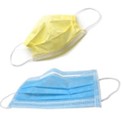
Purpose
Surgical masks are also known as dental masks or medical masks. They are loose-fitting, disposable devices which protect the wearer from large droplets, splashes, bone chips and sprays of blood, body fluids, secretions and excretions that may contain germs. They also protect others from the wearer’s personal respiratory emissions and pathogens. However, the edges of the surgical masks are not designed to form an airtight seal. As a result, they are incapable of protecting the wearer from inhaling smaller airborne particles, such as others’ respiratory emissions. Thus, they are not considered adequate personal respiratory protection.
Positioning
The masks should always be properly adjusted to fully cover the mouth and nose with no gaps around the nose or under the chin. Those gaps would allow air and droplets to bypass the filter medium. Because they do not provide a tight seal, leakage will inevitably occur around the edges of the mask. They do not require fit testing. However, there are a few things the wearer can do to ensure a proper fit. The flexible aluminum part of the mask is meant to be bent around the wearer’s nose. Additionally, the lighter side of the fabric faces inward, while the darker side faces outward.
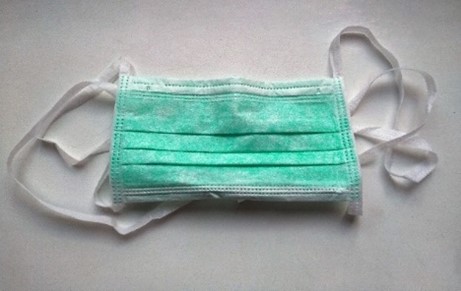
Reusability
Surgical masks should be discarded after each use or each patient encounter. The hands of the wearer should always be washed after coming in contact with a mask.
Cost
~ $0.30 – $0.80 per unit
COVID-19 Information
Surgical masks do not provide protection from inhaling smaller airborne particles, such as saliva, droplets from breathing, coughing, or sneezing.Thus, they are not considered adequate respiratory protection for users working with COVID-19 patients. However, surgical masks do an adequate job of preventing saliva from escaping a wearer’s mouth.
Homemade masks/Cloth masks
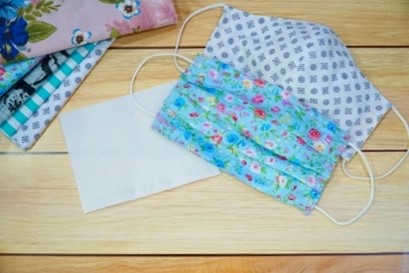
Purpose
Homemade facemasks provide some degree of protection from respiratory droplets that are coughed, sneezed, or emitted from talking. Like surgical masks, homemade masks do not form an airtight seal. As such, they are ineffective in protecting the wearer from smaller particles. However, homemade masks reliably protect other people from the wearer’s own respiratory emissions.
Positioning
Homemade masks fit just like surgical masks. The fabric covers the wearer’s face while the elastic bands loop around the wearer’s ears.
Reusability
Homemade masks are reusable if washable, and if possible, should be washed after every use. They can be laundered with other clothes.
Cost
~ $2 – $15 per unit
COVID-19 Information
Like surgical masks, homemade masks do not provide protection from inhaling smaller airborne particles, such as saliva.Thus, they are not considered adequate respiratory protection for users working with COVID-19 patients. However, homemade masks do an adequate job of preventing saliva and respiratory droplets from escaping a wearer’s mouth and protecting others.
Less Frequently Used Masks
P100 and N100 Respirators

Both P100 and N100 masks filter 99.97% of airborne particles and are used mostly in construction zones. P100 masks are used when working with oil-related hazards.
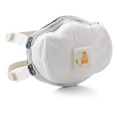
N100 masks are used in jobs that do not include oil-based hazards. The cost per unit is about $5-10.
PAPRs
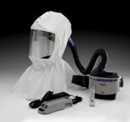
Unlike previously mentioned respirators, PAPRs (powered air purifying respirators) fit over the wearer’s entire face, instead of just the wearer’s mouth and nose. PAPRs are battery-powered respirators that provide airflow through a filter. Standard models also include a hood, which eliminate the need for fit testing. The cost per unit can reach upwards of $700-900.
SCBAs – Self-containing breathing apparatus
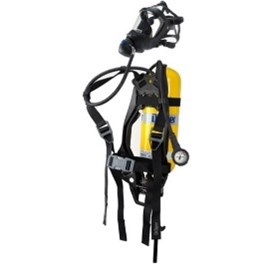
Unlike previously mentioned respirators, SCBAs (self-contained breathing apparatuses), in addition to containing a full-face enclosure, contain a pressurized tank of breathable air. SCBAs are commonly used by firefighters. If designed for use underwater, they are called SCUBAs (self-contained underwater breathing apparatus). The cost per unit can be anywhere around $2500-4000.
In summary:
- When we talk, breathe, cough or sneeze, we produce particles. Some of these particles may be droplets, others may be aerosolized (i.e. smaller < 5 microns in size).
- It is very likely that the virus will be inside these particles of an infected person.
- The size and concentration of these particles will be different depending if they were produced by a cough or an exhaled breath. In general, large particles will fall to the floor quickly and small particles will travel further and are more likely to slip through protective masks.
- Smaller particles do not necessarily have a smaller viral load. In fact, smaller particles may actually have higher amount of viable virus present. These small particles are dangerous if they are inhaled deeply in the lungs.
- For all these reasons, social distancing is essential. Everybody should maintain a 6-foot distance.
- At this time of COVID19 pandemic, N95 respirators have been prioritized for healthcare workers and first responders and not for the public or general use.
- Surgical masks offer some level of protection but do not provide a tight facial seal and have not been proven to be effective in filtering smaller particles.
- According to current recommendations (during the COVID19 pandemic), you should be wearing a face mask whenever you go out in public to prevent spreading respiratory particles to others. Asymptomatic people who do not wear masks could be unknowingly spreading the disease.
- No mask or respirator provides an absolute protection. Correct donning and doffing procedures are needed to achieve suitable protection.
- Additionally, frequent hand-washing and social distancing is essential to slowing the spread of disease.
Richard Criley is a student at the University of California Berkeley, Haas School of Business. He has been a contributing member of Indelible Learning since its inception: from Teaching Assistant for over 10 years, to teaching, leading, brainstorming and analyzing ideas, creating educational content, producing videos, directing the content, presenting at local, regional and national conferences and much more.
Dr. Jasminka Vukanovic-Criley MD, FACP, FHM is a multiple award-winning physician, internist, hospitalist, healthcare & education innovator & Associate Clinical Professor of Medicine at UCLA. She is a career mentor & advisor to numerous undergraduate, graduate & postgraduate students & faculty. As a researcher, Dr. Criley received awards from the National Institutes of Health & the U.S. Department of Education Her work focuses on creating research-driven #edtech games & digital media to improve health, civics, science education & promote healthy habits. Dr Criley is also a sought-after speaker & a founding Board member of Physician’s Weekly. She can be reached on X at @criley_md and at www.linkedin.com/in/jasminka-criley-md